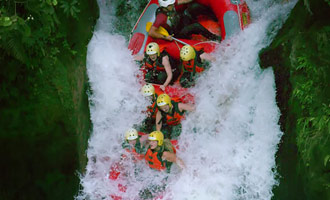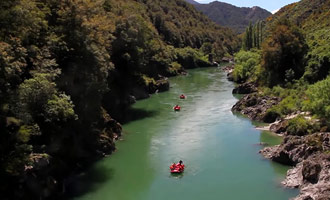
The Best Rafting Excursions in New Zealand.
Please contact us and we will help you to organize your trip! It's free and without commitment.
- Read the post
- Details
- Advices
The Practical Guide of the Activity.
- 1Even Beginners Can Go Rafting!
- 2Which Rafting Adventure to Choose?
- 3Equipment and Training Before Departure.
- 4Build Your Rafting Team!
- 5Rafting in the Rapids.
- 6How to React if You Fall Into the River?
- 7Excursions with Rafting New Zealand (Taupo).
- 8Excursions With Queenstown Rafting.
- 9Is Rafting a Dangerous Sport?
Even Beginners Can Go Rafting!
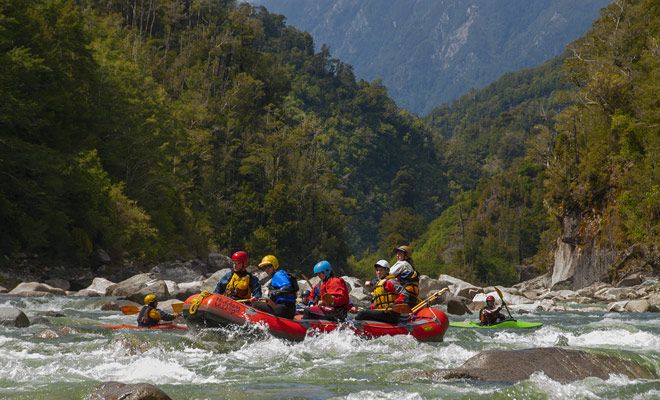
The New Zealand rapids are perfect for rafting.
Volcanic activity has carved the landscapes of New Zealand. The highly marked relief is perfect for rafting activities and the regular rains reinforce the power of the rapids. Rafting experts do not hesitate to classify the rivers of the country among the best in the world.
I will explain to you how to book a rafting activity adapted to your profile, and I will then introduce the best rivers of the country.
You will have fun, even if you have never touched a paddle in your entire life. Rafting in New Zealand is perfect for both beginners (including families) and thrill seekers. Of course, I'm well aware that you want to know your chances of falling into a river above all, and I will cover this subject as well.
It is perfectly normal to question yourself about the risks and an important part of this guide will deal with the safety instructions.
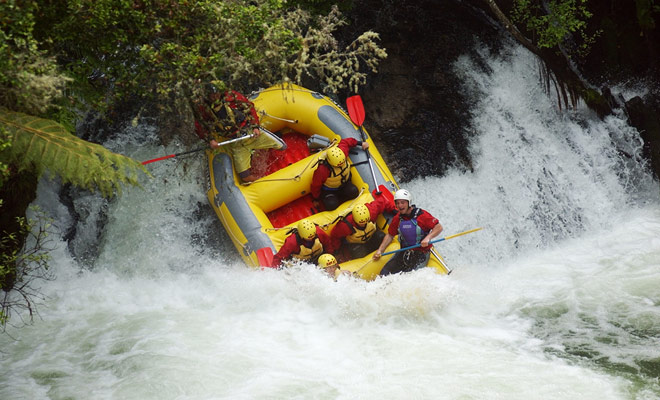
Rafting provides incomparable sensations.
You should definitely enjoy rafting, especially in a country where the activity takes place in dream landscapes.
And if you are not always convinced, I can tell you that people who have tried the rafting in New Zealand are rating the experience as extraordinary (some rafting operators receive 99% of positive votes on Trip Advisor).
Keep in mind that rafting is a discipline that requires concentration and team spirit.
You must be in good physical condition, know how to swim and not be afraid to get wet if you want to join a rafting outing. If not, you would be well advised to pass your turn.
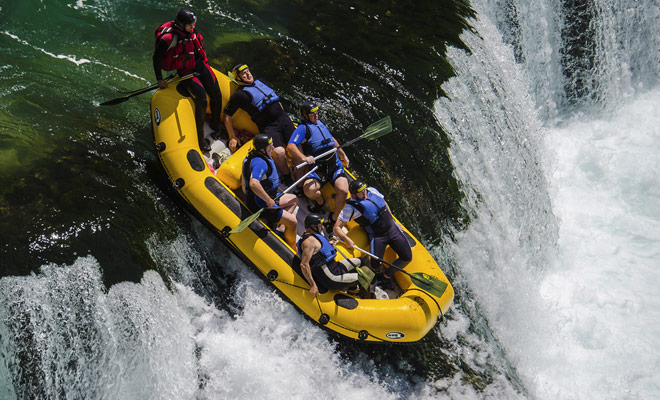
Rafting is a sport that provides thrills.
If you feel ready to go through rapids to relive the heroic escape of the dwarfs in the Hobbit movie, or if you want to discover the unfolding of an outing, Kiwipal is pleased to present the complete guide to rafting in New Zealand.
Which Rafting Adventure to Choose?
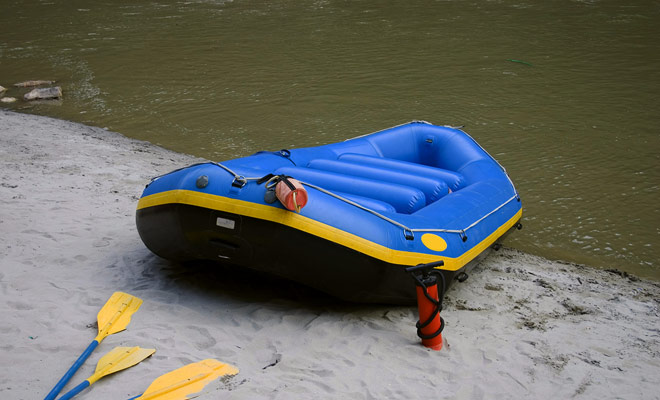
Beginners can practice rafting in New Zealand.
Before you sign up for a rafting trip, you must consider the type of river you are going to select. Fortunately there is an international classification which will help to choose according to your class.
Here is a table summarizing the classes of difficulty:
| Class | Difficulty | River |
|---|---|---|
| 1 | Easy | River without obstacles with a little eddy and small waves. |
| 2 | Begginer | Rapids on a river without obstacles. |
| 3 | Intermediary | Rapids with waves sufficient to sink a submersible craft, but without dangerous obstacles. |
| 4 | 4 Advanced | Powerful rapids without dangerous obstacles, but requiring more concentration. |
| 5 | Expert | Very powerful and often unpredictable rapids on a river full of obstacles. |
When visiting websites dedicated to rafting, you need to know is that what is called “White Water Rafting” refers to the rafting in rapids.
I precise that we are going to talk exclusively of guided tours organized by specialized rafting companies. I do not recommend improvised outing.
Therefore, if you want to go down a river with your children, you should book Class 1 or Class 2 rivers if you are traveling with young teenagers. Adults, even beginners, can directly book Class 3 rivers or even Class 4 if they are looking for strong sensations.
On the other hand, level 5 is only for experts who regularly practice rafting. Some rafting companies nevertheless allow beginners to book such a high level outing, and if I do not endorse this practice, I confess that I have not received any negative feedback so far.
Equipment and Training Before Departure.

Before embarking, you must know the basics of rafting.
You are not going to board the raft and start descending the river without a minimum of training. It takes place on the dry land in the company of a guide who presents the different situations to which you might be confronted.
As soon as you talk about rafting, beginners imagine drowning ... Yet, this sport would not have become as popular if it was so dangerous! The organizers that I will present here are renowned for their professionalism.
You will learn how to react in the event of a fall in the river. The right attitude to adopt is not intuitive, but makes sense! It consists of swimming on the back by putting your feet forward to reduce the risk of collisions.
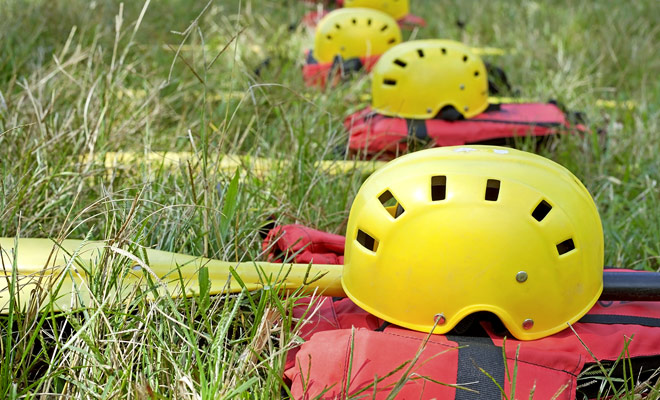
Compulsory equipment with helmets and life jackets.
The equipment provided by the organizer includes the combination, the life jacket and, of course, a helmet and a paddle.
Simply bring the swimsuit that you will wear under your suit, not to mention a towel (to dry yourself at the end of the day).
Note that helmets are mandatory on Class 3 rivers and beyond.
They serve to protect you from possible shocks with rocks, and to guard you against the blows of paddles that could accidentally give you another participant.
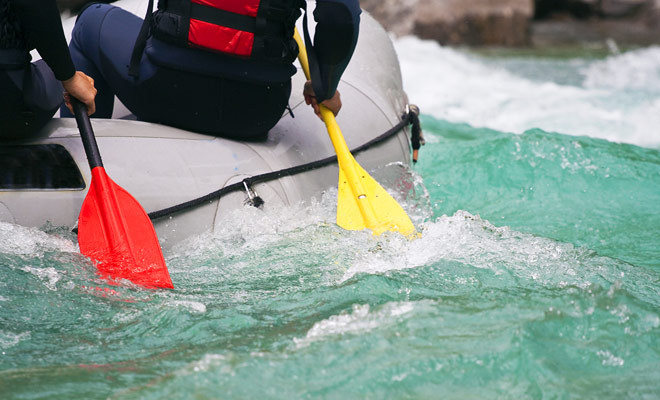
You will quickly learn how to paddle in rhythm with the team.
It is also an essential safety rule: always hold your paddle with both hands! Participants must stay focus and warn each other (this is part of the rafting team spirit).
At this stage of the formation, it is perfectly normal to feel a slight apprehension, but it will be quickly dissipated: to succeed in putting your combination should cause the first bursts of laughter of the day.
Build Your Rafting Team!
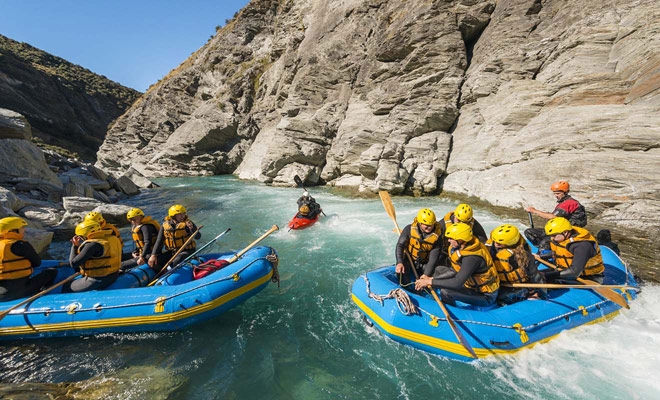
The crew competitions are fun.
Rafting is an ideal team sport for making friends. Several hours spent assisting each other on rapids, until the happy evening in the restaurant where people remember the best moments of the day while eating a giant pizza!
You can rely on your guide to distribute participants according to their physical abilities.
The most muscular rowers will sit at the front where they can deploy all their energy.
Depending on the difficulty of the river, the raft accommodates from 4 to 8 passengers without counting the guide.
Master on board, the guide is positioned at the rear of the raft, from where he communicates his orders to the team.
Each descent in rafting is unique, but the guide knows his river by heart and gives instructions in advance as a conductor.
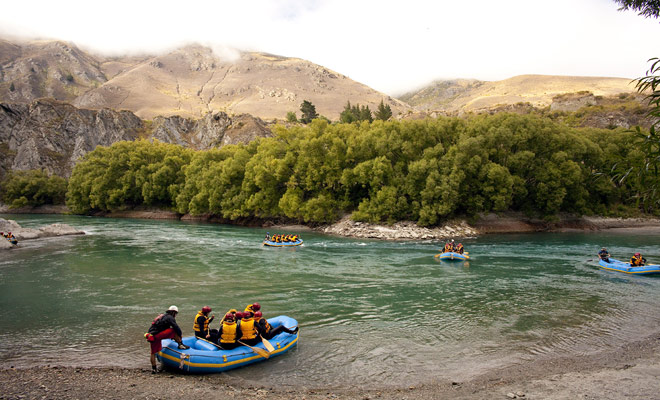
The number of participants varies depending on the difficulty of the river.
Rest assured, all outings begin on calm waters.
You will have enough time to repeat the basic movements before being confronted to rapids. All orders are meant to be simple: “go on, wait, let go, stop on the left ...”
The more the team performs synchronized movements, the more likely it will win the improvised races with the other rafts. A minimum of discipline is indispensable, but this state of mind is not incompatible with good humor and bursts of laughter!
Rafting in the Rapids.
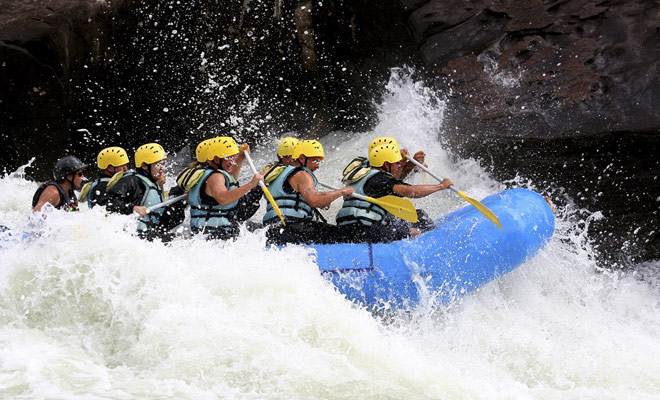
Fortunately, you will not be alone in paddling!
Rafting is an activity that requires energy, especially in rapids where the intensity varies according to the weather. Strong precipitation on the previous day increases the power of the current, and the eddies shake the participants more.
The rhythm is often unpredictable, but calm sequences allow the beginners to recover forces.
These peaceful moments allow the guide to evoke the history of the region and Maori legends.
But in fast, you will not have any time for a break!
The presence of other rafts makes it possible to engage races between crews.
Expect a few aches in the arms next morning if you are a beginner, but the experience is unforgettable.
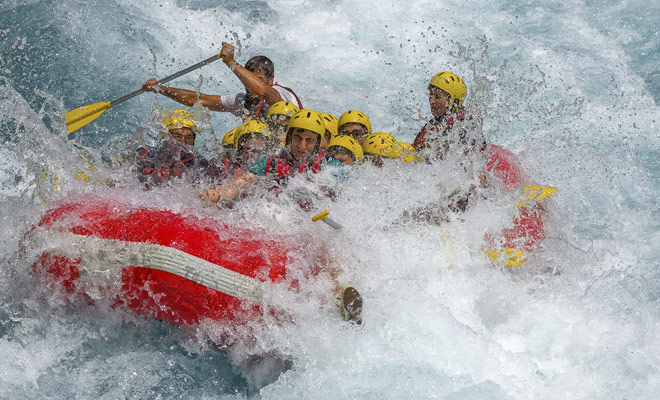
In reality, rafting requires energy, but is not exhausting.
The rapids are not always physically exhausting! If the river is wide enough and in a straight line, you just have to get carried away by giving a few paddles to rectify occasionally the trajectory. And if a fall appears, rely on the experience of your guide to approach it in the best conditions.
Finally, I am often asked where is the best position on board ?
To tell the truth, you will be soaked no matter where you will be seated, but anyone who has already experienced rafting knows that it is better to sit at the back of the raft to avoid many splashings.
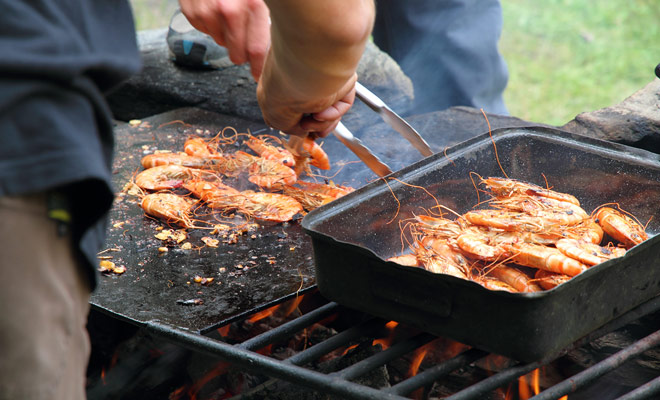
You have well-deserved rest and a good barbecue!
The water of the rivers is fresh and the traditional break “cookie + hot drink” at half-way is always appreciated.
Whatever the season, a hot shower is essential to recover at the end (some companies even offer hot dogs and beers).
How to React if You Fall Into the River?

Falling in the water is an integral part of this sport.
Falling in the water is the beginner's obsession. Some will tell you that the fall is part of the sport, but you can reduce the risk by using the foot straps. These small straps make it possible to paddle without losing the balance in the middle of the rapids.
It seems legitimate to ask whether the raft can sink like the Titanic.
In fact, the raft is an unsinkable inflatable dinghy made up of several independent watertight compartments. A waterway would not call into question the buoyancy of the raft.
There is no need to panic if a fall occurs, even if you are in rapids.
Try to swim on your back and keep your legs stretched in the direction of the current so you do not risk a collision with the debris at the bottom of the river.
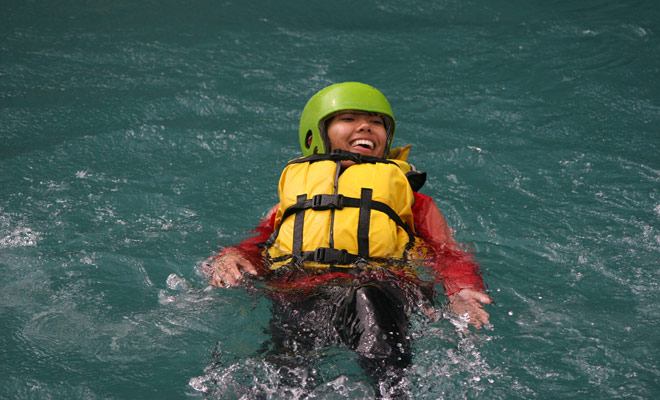
If you fall in water, just let yourself be carried by the current.
Your life jacket is enough to keep your head above water, and you will not be left on your own during a long time anyway... If the current permits, the team will maneuver the raft to fish you. If not, a second guide that follows in a kayak will take care of you.
The rope that goes around the raft and which is called “lifeline” facilitates the return on board of a participant in case of fall in the river.
But if the fear of falling into the water prevails, I recommend you to choose a Class 2 river where the risk of falling is practically zero. Even on a Class 3 river, you have little chance of falling. The risk is more serious at Class 4, but the life jackets protect you effectively.
Excursions with Rafting New Zealand (Taupo).
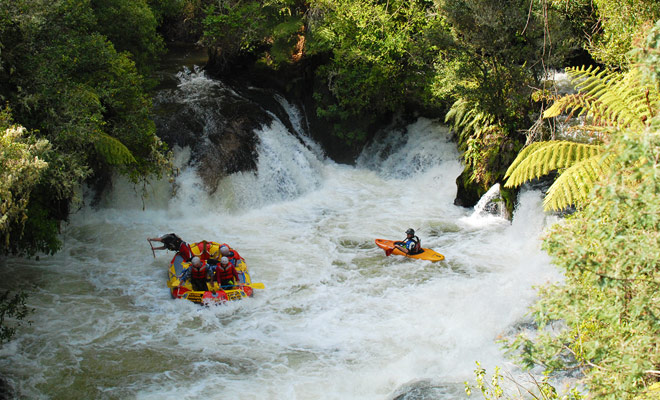
A rafting trip with Rafting New Zealand.
Lake Taupo occupies the caldera of a super volcano whose last apocalyptic eruption changed the face of the world 26,500 years ago. The Tongariro River you can descend in rafting was born during this planetary catastrophe.
La compagnie Rafting New Zealand has been based in Turangi for more than 20 years, but shuttles are available to customers in Taupo.
I am not alone in recommending this organizer who has been awarded many times at the New Zealand's Awards in the Rafting category since 2010.
The Formulas
Three different outings are available, but the first one is only aiming families with small children (with a swimming break included).
The “White Water” (Class 3) and Upper Gorge (Class 4) itineraries are exceptional if you're looking for thrills. The Class 4 itinerary is, however, conditioned by the opening of a dam and you will have to contact the company to know the schedules.
Outings are organized throughout the year, with more frequent departures in summer (and highest rates). Count a half day of activity, of which 2h (sometimes 2h30) are spent on the water. Here is a summary table.
| RIVER | CLASS | ADULT | CHILD |
|---|---|---|---|
| Tongariro Family Fun | 2 | $90 | $70 |
| Tongariro White River | 3 | $129 | $119 |
| Tongariro Upper Gorge | 4 | $129 | $119 |
One must be at least 13 yo. to participate to Tongariro Upper Gorge.
Rates and online booking with Rafting New Zealand.Excursions With Queenstown Rafting.
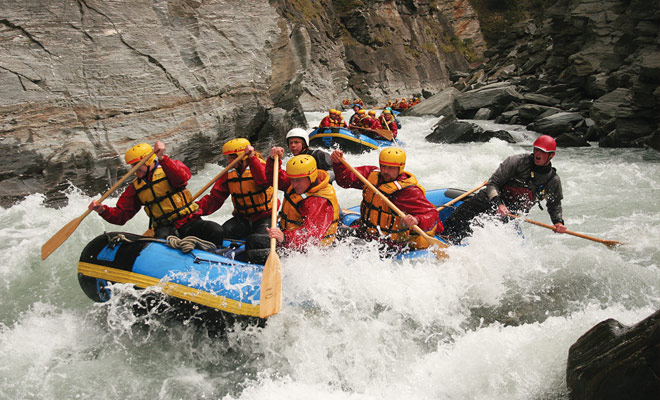
Queenstown rafting has been running outings for over 40 years.
Queenstown, known as the world capital of adventure attracts extreme sports fans as a magnet. After giving birth to the bungee jumping and jet boat tours, the region hosts rafting trips on the Kawarau and Shotover rivers.
The is a is one of the oldest companies in New Zealand, with an activity dating back to 1974.
It offer a free shuttle from Queenstown to the Shotover and Kawarau rivers. The excursions last about 4:30, with half of the time spent on the river.
The quality of the coaching allows this organizer to eclipse all its competitors. You can book with your eyes closed!
The Formulas
The peculiarity of the Queenstown Rafting formulas is that the difficulty of the rivers is not linear. It is an undeniable advantage that allows to propose thrills (some passages flirt with Class 5) without exhausting the participants.
The Shotover River made the fortune of the prospectors, but the veins are now exhausted.
According to most experts, this is the most beautiful rafting river in New Zealand.
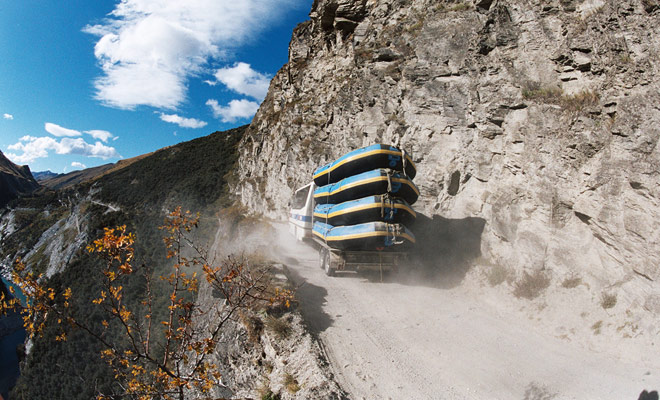
The starting point is always upstream of the river.
The 12 km itinerary takes place on a turquoise water, with rapids whose difficulty passes successively from average to difficult in the Skipper Canyon. You will even borrow the Oxenbridge Tunnel dug by the gold diggers!
The Kawarau River is a more affordable river (Class 2 to 3) suitable for adults and teenagers who like to race between crews. But the rapids are rare, which can disappoint thrill seekers.
| RIVER | CLASS | ADULT |
|---|---|---|
| Kawarau River | 2 | 209 $ |
| Shotover River (summer only) | 3 (4 and even 5 sometime) | $209 |
Child under 13 yo. must be with by an adult on Kawarau River.
The company also offers an outstanding outing on the Landsborough River. A 3-day excursion for a high price of $1600.
Schedules and booking on the Queenstown Rafting site.Is Rafting a Dangerous Sport?
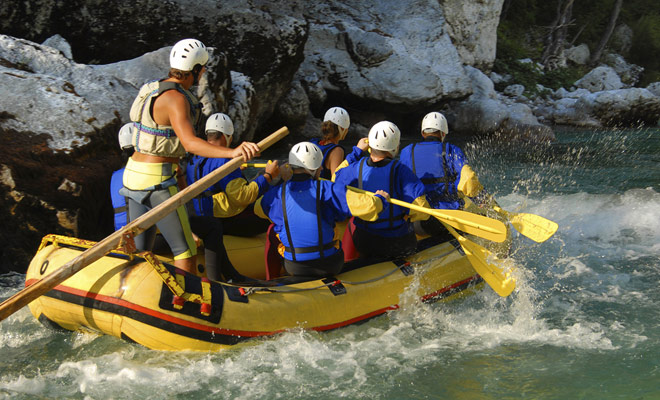
Rafting is a very framed sport.
The rafting companies that I recommend exist since decades. You will be perfectly supervised by professionals who practice the activity daily and are accustomed to managing teams of beginners.
Each guide has a first aid certificate and outstanding swimmer skills. They are above all professionals who work with a smile, but who always double-check the material in the smallest detail.
Rafting is often considered dangerous because it is systematically associated with class five rapids that are not intended for beginners.
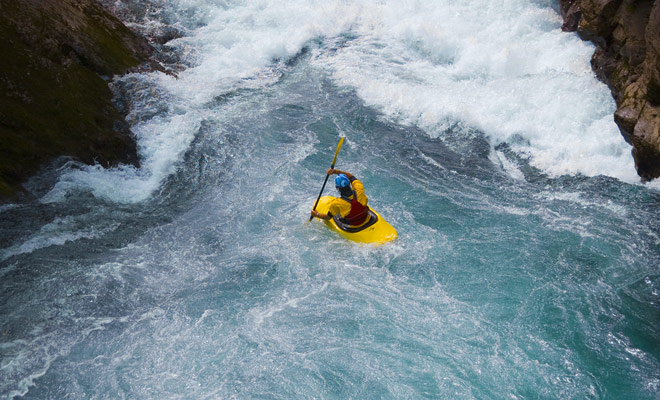
A kayak instructor catch participants who have fallen into the water.
But for the Cartesian minds who only swear by the numbers, I dug the subject to find you the real rafting's accident statistics each year.
There are 100 to 150 wounded per year per 100,000 participants. With a risk rate of 0.1%, there is nothing to be worried about...
Compared to mountain biking which creates ten times more accidents, the rafting would pass for a harmless sport (I spare you the comparison with road traffic).
However, this activity requires to be fit enough and accompanied by a guide.
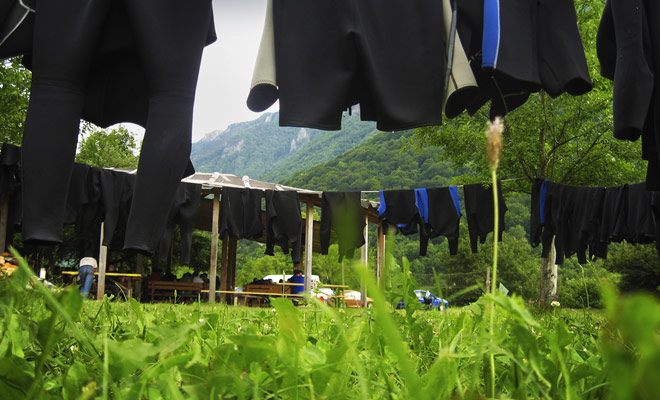
Rafting in New Zealand leaves an unforgettable memory.
If you have absolutely no strength in your arms, and you do not like endurance sports, it's better to pass your turn. If, on the other hand, you practice a sport regularly and your doctor gives his consent, indulge yourself!
Rafting is one of the best activities you can book for your stay in New Zealand. I am glad to have made you discover it, and the time has come to pass on the relay to our friend Ben for practical questions.


Questions & Answers.

What can I do for you? If you are not afraid to get wet and you have team spirit, I am ready to answer all your questions about rafting in New Zealand.
- All topics ... 29 answers in total
- Safety Instructions 7 answers
- Prerequisites for Rafting 5 answers
- Rafting Equipment 5 answers
- Booking a Rafting Activity 4 answers
- Rafting Budget 3 answers
- Weather Forecast and Season for Rafting 3 answers
- Photos and Videos 2 answers
Safety Instructions
- Is the rafting monitored by a guide?
There is always a professional guide in each raft to supervise the maneuvers. A second monitor follows in kayak and usually communicates by radio.
- Can we fall off the raft?
It is a risk to consider, but rest assured, the life jacket keeps the head out of the water and the helmet protects you from shocks.
- Are we tied aboard the raft?
No, because rafting requires total freedom of movement to paddle. The guide will show you how to sit properly while minimizing the risk of falling.
- How to get back in the raft if you fall?
In reality your life jacket prevents you from re-entering the raft. However, it is by grabbing you by the life jacket that you are easily picked up.
- Can the raft fill up with water and sink?
No, because an evacuation system prevents the raft from turning into a swimming pool.
- What happens if I lose my paddle?
In general the lost material is found at the "next flat" (sections where the river is calm).
- Should we prefer shallow rivers for rafting?
Contrary to what one might think, the shallower rivers are the most dangerous. In a river where one has feet, the chances to be kept prisoner by a rock or a branch are more important.
Prerequisites for Rafting
- What is the recommended age and weight to register?
Participants must be over 13 years of age and weigh more than 40 kg to descend a river of Level 3 or higher.
- Should you be a good swimmer to register?
If you have already swum in a sea with medium waves, and you are not afraid to be a little shaken, there will be no problems.
- Should I have already practiced rafting to register?
Beginners are welcome, and the little formation provided is sufficient to have fun like everyone else.
- Can we participate if we have health problems?
Only your doctor can give you an answer. I recommend doing a medical check-up before the departure, especially if you are prone to asthma attacks.
- Can you kayak if you are pregnant?
Curiously, this question comes up regularly. The answer is obviously negative except for the peaceful rivers of level 1 or 2 (inquire directly with the company).
Rafting Equipment
- Am I going to get soaked during a rafting trip?
What a question ! You will be soaked, but this is no problem because you will wear a combination.
- Should I bring a spare outfit?
Take a swimsuit and a beach towel for you to dry and enjoy a good hot shower in the company's premises after the activity.
- Is the combination mandatory in rafting?
Yes, because city clothes dry very slowly and do not retain the heat unlike the neoprene suits.
- What shoes to wear for rafting?
The waterproof shoes are lent by the organizers, and you recover your belongings at the deposit after the activity.
- Can we wear glasses or contact lenses while rafting?
This is possible, but it is strongly recommended providing glasses with a fastener because they may fall into the water. The company makes you sign a waiver and will not compensate you if you lose your stuff. Contact lenses do not usually pose difficulties.
Booking a Rafting Activity
- Should we book a rafting trip?
During the high season, it is necessary to reserve to hope to participate. The rest of the year, you should be able to register the same day. Beware, however, of school holidays.
- Are there shuttles to reach the departure point?
In general, a free shuttle is available for participants staying in Queenstown or Taupo.
- What is the total distance traveled in rafting?
You will descend most of the rivers for about 15 to 20 km.
- How long is an outing on the Shotover River?
Allow approximately 4h30, or half a day for the complete activity which includes training. You will spend about 2h30 on the river (sometimes less depending on the level of the group). It is not a recreational park activity: the duration is variable and depends on the crew and the river.
Rafting Budget
- Are there any discounts for groups ?
It all depends on what you mean by group! It takes at least eight participants to hope for a reduction (and again ...). Organizers are generally more inclined to make efforts on tariffs during the low season.
- How many participants are required for an outing?
It all depends on the river! For a river level one to two, just four participants. But organizers need six to seven passengers to fill a raft on a level 3, 4 or 5 river. This does not mean you have to come with all your family and friends, but there must be other guests who book for the same tour.
- Can we cancel a rafting trip?
The cancellation policy varies by company. In general, a 24-hour notice is required to claim a full refund.
Weather Forecast and Season for Rafting
- Can you practice kayaking in bad weather?
To the extent that you will be soaked whatever happens, you can practice rafting in all weather unless it is too cold.
- Can we do rafting in winter?
The winter is quite mild in New Zealand, and the combinations are thick enough to keep the body warm. But I do not advise coming if the thermometer is below 10 ° C and if there is a wind.
- Are the outputs canceled if it rains?
No, to the extent that the river will be more pleasant to navigate. You'll be wet anyway.
Photos and Videos
- Can I bring my camera?
The ideal would be to opt instead for a GoPro camera with a front attachment. You will be too busy to take pictures on a river level 3 or 4, but most organizers let you come with your cameras (at your own risk).
- Should I buy the photos or videos from the shop?
I never thought it was necessary, but if you absolutely want to keep a souvenir, it's possible. One rule not to be disappointed: always ask to see the result before you buy.

